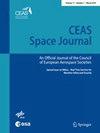Analysis of the thermal design of a COTS-based modular battery system for satellites by thermal vacuum testing
IF 1.8
Q2 ENGINEERING, AEROSPACE
引用次数: 0
Abstract
Abstract The qualification of components for satellite applications is a costly process due to the extreme conditions that must be endured in space. Therefore, space market access of battery technology innovations is often inhibited. However, modern battery technologies offer great advantages for satellite applications. In this work, a commercial off-the-shelf (COTS) based and modular lithium-ion battery system for satellites in Low Earth Orbit (LEO) is presented. A comparative analysis to evaluate system parameters and functionality of the proposed battery system and literature data is performed. A thermal vacuum test campaign is carried out to investigate the behaviour under LEO relevant conditions and to achieve qualification of the system performance according to the ECSS (European Cooperation for Space Standardization) standard. The tested system consists of two modules with 28 V nominal voltage and eight battery cells each. Experiments were conducted inside a vacuum chamber. The battery system was charged and discharged in temperatures from 0 °C to 45 °C in a high-vacuum for three weeks. The influence of the battery management electronics, the behaviour of the cells and the heating were analyzed. The cell temperatures stayed in the operating limit during 3.5 A and 10 A cycling. The battery system, however, exceeded the cell’s upper operating limit with a 40 °C baseplate and 3.5 A charging. Despite the dense system architecture with electronics between the cells the battery system can safely deliver power in a broad temperature range. Further investigations regarding safety and failure modes are necessary, along with advancements on software and state estimation algorithms.基于cots的卫星模块电池系统热真空热设计分析
卫星应用部件的鉴定是一个昂贵的过程,因为必须忍受空间中的极端条件。因此,电池技术创新的空间市场准入往往受到抑制。然而,现代电池技术为卫星应用提供了巨大的优势。在这项工作中,提出了一种基于商用现货(COTS)和模块化的低地球轨道卫星锂离子电池系统。对所提出的电池系统和文献数据的系统参数和功能进行了比较分析。开展了热真空测试活动,以调查在LEO相关条件下的行为,并根据ECSS(欧洲空间标准化合作)标准获得系统性能的资格。测试系统由两个模块组成,每个模块具有28 V标称电压和8个电池单元。实验是在真空室内进行的。电池系统在0°C至45°C的高真空环境中充电和放电三周。分析了电池管理、电子器件、电池性能和加热的影响。在3.5 A和10 A循环期间,电池温度保持在工作极限。然而,该电池系统在40°C底板和3.5 a充电时超过了电池的最高工作极限。尽管电池之间有密集的电子系统结构,但电池系统可以在很宽的温度范围内安全地供电。随着软件和状态估计算法的进步,对安全性和故障模式的进一步研究是必要的。
本文章由计算机程序翻译,如有差异,请以英文原文为准。
求助全文
约1分钟内获得全文
求助全文
来源期刊

CEAS Space Journal
ENGINEERING, AEROSPACE-
CiteScore
3.90
自引率
7.10%
发文量
67
期刊介绍:
The CEAS Space Journal has been created by the CEAS Space Branch to provide an appropriate platform for the excellent scientific publications submitted by scientists and engineers. Under the umbrella of CEAS, the German Aerospace Center (DLR) and the European Space Agency (ESA) support the Journal. The Journal is devoted to new developments and results in all areas of space-related science and technology, including important spin-off capabilities and applications as well as ground-based support systems and manufacturing advancements. Of interest are also (invited) in-depth reviews of the status of development in specific areas of relevance to space, and descriptions of the potential way forward. Typical disciplines of interest include mission design and space systems, satellite communications, aerothermodynamics (including physical fluid dynamics), environmental control and life support systems, materials, operations, space debris, optics, optoelectronics and photonics, guidance, navigation and control, mechanisms, propulsion, power, robotics, structures, testing and thermal issues and small satellites. The Journal publishes peer-reviewed original articles, (invited) reviews and short communications.
 求助内容:
求助内容: 应助结果提醒方式:
应助结果提醒方式:


